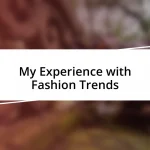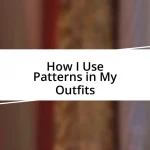Key takeaways:
- Color theory significantly influences wardrobe choices, with color relationships like complementary and analogous pairs affecting emotional responses and confidence.
- Colors act as silent communication tools in fashion, impacting perceptions and moods, while also playing a crucial role in branding and identity.
- Mixing and matching colors effectively involves coordinating palettes and incorporating textures, creating cohesive outfits that tell a visual story and express personal style.

Understanding Color Theory Basics
Color theory is the foundation of how we perceive and use color in fashion. I remember the first time I played with a color wheel in art class; it felt like opening a door to a whole new world. Seeing how primary colors mix to create secondary shades sparked a fascination that still influences my wardrobe choices today—don’t you find it intriguing how certain colors can evoke specific feelings?
Understanding the relationships between colors, like complementary and analogous colors, reignites my excitement every time I select an outfit. For example, wearing a rich blue paired with a warm orange can create a striking contrast, while greens and blues harmonize beautifully, reflecting tranquility. Have you noticed how some color combinations make you feel more confident, while others might feel too bold for everyday wear?
Additionally, the psychology of color plays a vital role in fashion decisions. When I wore a red dress to a gathering, I felt empowered and vibrant; it was like the color itself was whispering confidence into my ear. What about you? Which colors do you find resonate with your mood or style? Recognizing these nuances not only enhances our personal choices but can significantly impact how we express ourselves to the world.

Importance of Color in Fashion
Color in fashion isn’t just a matter of aesthetics; it profoundly influences our moods and perceptions. Reflecting on my experiences, I recall a time I wore a pastel pink blazer. The compliments I received weren’t just about the style; people seemed to respond positively to its warmth and softness. It’s fascinating how color can act as a silent communication tool in our outfits, conveying emotions before we even say a word.
Moreover, the importance of color extends to branding and identity. For instance, I once worked on a project for a startup aiming to project a vibrant, youthful image. We carefully selected a bright color palette that embodied energy and enthusiasm. The outcome? The brand resonated with its audience, illustrating how color can elevate an entire fashion statement beyond mere clothing choices.
Lastly, color also plays a role in trends and seasons. I remember shopping for jewel-toned accessories during fall; they just felt right, as though they encapsulated the spirit of the season. Trends often shift, but the core impact of color remains constant, prompting us to embrace certain shades to feel aligned with the current fashion dialogue.
| Color Effect | Emotional Response |
|---|---|
| Warm Colors (e.g., Red, Orange) | Excitement, Energy, Passion |
| Cool Colors (e.g., Blue, Green) | Calm, Serenity, Trust |
| Neutral Colors (e.g., Black, White) | Balance, Sophistication, Timelessness |

Mixing and Matching Colors Effectively
Mixing and matching colors effectively is an art that I’ve come to appreciate over the years. I still remember a day when I paired a mustard yellow top with deep navy trousers. The contrast was striking, yet somehow, it felt like they belonged together. Have you ever stumbled upon a combination that just clicked for you? It’s those serendipitous moments that help refine our color instincts.
I find that sticking to a color palette with a few coordinating hues makes blending easier. For instance, when I planned a casual outfit for brunch, I chose earthy tones—like olive green and terracotta. As I layered my pieces, I was pleasantly surprised by how those soft, muted shades complemented each other, creating a warm, inviting vibe. This approach not only simplifies decisions but can make your wardrobe choices feel cohesive and intentional.
Sometimes, I also play with texture to elevate a color combination. I remember wearing a silky champagne blouse with a chunky knit cardigan in a rich burgundy. The mix of textures, combined with the contrasting colors, created a depth that turned heads. How does that make you feel when you see different textures in an outfit? It’s a tangible reminder that mixing colors can be about more than just the shades themselves; it’s about creating a visual story that captures attention and expresses your personal style authentically.














